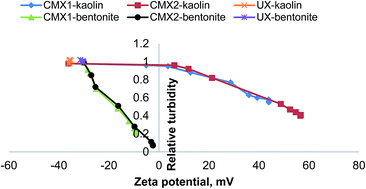Cationic xylan–METAC copolymer as a flocculant for clay suspensions
Abstract
The work presented herein focused on the flocculation of kaolin and bentonite clay suspensions using cationic copolymerized xylan under controlled conditions. Cationic xylan-2-(methacryloyloxy)ethyl]trimethyl ammonium chloride (METAC) copolymers were produced under the conditions of pH 7, 3 h reaction time, 80 °C and 2 or 3 mol mol−1 METAC/xylan ratio. The charge densities of the produced cationic xylan copolymers, CMX1, and CMX2 were +1.8 and +2.4 meq. g−1 while their molecular weights were 88 986 and 102 545 g mol−1, respectively. The attachment of METAC to xylan was confirmed by elemental and gel permeation chromatography analyses. CMX2 was a more efficient flocculant than CMX1 as it adsorbed and removed more clay particles from the clay suspensions. CMX2 also changed the zeta potential and turbidity of the clay suspensions more remarkably than CMX1, which was attributed to its higher charge density and molecular weight. CMX2 was more efficient in flocculating bentonite than kaolin suspensions. The presence of CMX on the clay particles was confirmed by Fourier Transform Infrared Spectroscopy (FTIR) analysis. The size of kaolin particles increased from 3.2 to 9.8 and 11.7 μm, and that of bentonite particles from 5.8 to 13.8 and 15.5 μm by having 16 mg L−1 of CMX1 and CMX2 copolymers in the clay suspensions, respectively. The reversibility of the flocculation process was assessed with a photometric dispersion analyzer. Furthermore, unmodified xylan was ineffective in flocculating clay particles.


 Please wait while we load your content...
Please wait while we load your content...